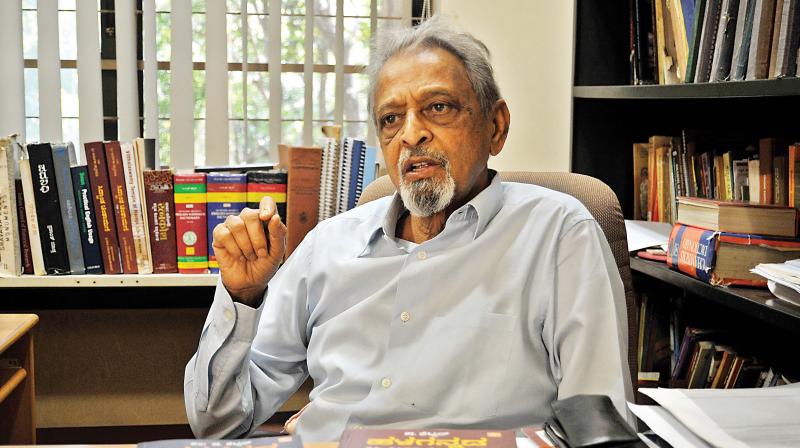How king Ashoka scripted Kannada to glory
Dr. S Settar will take the stage this weekend at the Bangalore Literature Festival to discuss the origins of the Kannada language.

The earliest known inscriptions in Kannada date back to the 4th century BC. By 400 A.D., however, the Sangam era, which flourished from about 300 BC, made little or no reference to Kannada as a language. As the local script evolved it became a point of great pride for its people, who used it prolifically. Over 55,000 inscriptions were found in the area, historian Dr S. Settar tells Aksheev Thakur, as he retraces Deccan history through the evolution of its languages.
When Hoysala Sculpture in the National Museum was published in 1975, Dr. S Settar, then Professor of History and Archaeology at Karnataka University, set himself apart as one of the state's most distinctive historians and scholars. Now a senior faculty member at the National Institute of Advanced Studies, Dr. S Settar will take the stage this weekend at the Bangalore Literature Festival to discuss the origins of the Kannada language.
Linguistic conflicts are a major part of mainstream life today, with bitter struggles to safeguard and promote local tongues, spurred on perhaps by the age, marked by integration and global togetherness. It may surprise some to know, therefore, that the seeds of this conflict were first sown thousands of years ago. Dr Settar takes us back to 300 BC, to the time of the great Mauryan Emperor Ashoka, who introduced the Brahmi script to Deccan India. This, he says, gave birth to the two oldest languages of India – Tamil and Kannada.
“The emperor brought with him the Brahmi script and also Prakrit, the language of the masses.” Religious icons like the Buddha and the Jain Tirthankaras owe their popularity, in part, to the fact that they sought the language of the masses, Prakrit, in their journey away from traditional Vedic teachings, he explains. This was a significant departure, one Dr Settar puts in perspective with an analogy: the pervading Brahminical attitudes of the time. Brahmins considered the consumption of onion and garlic to be non-Aryan, while any language that wasn’t Sanskrit was shunned as ‘foreign’. This orthodoxy, he explains, made Sanskrit the language of the elite, leading to religious offshoots of Hinduism that emphasised use of the common tongue.
“This is why the masses never learned Sanskrit, which was a means of verbal communication,” he said. It was used to orally transmit the Vedas, which weren’t written down at the time, while providing the Brahminical classes with assurance that Vedic teachings wouldn’t be received by anyone outside the Aryavarta region.
However, with the advent of Kushanas, who Dr Settar points out were vociferous advocates of Hinduism, Sanskrit was revived. “It is interesting to note down that the first Mahakavya in Sanskrit was written by a Buddhist monk, Buddhaghosa in 1-2nd Century AD. This is due to the importance Sanskrit enjoyed under Kushanas,” he says.
The Buddhists, after the arrival of Kushanas, used Sanskrit for over 300 years and by 300 A.D., Kannada developed. Though vernacular languages were spoken in South India at a time when Sanskrit was widely used in Aryawarta, verbal communication in the Deccan region was not disciplined.
The Kannada script, however, evolved from Brahmi. In his research, Dr Settar found that communication in South India, dating back to between BC 300 to and AD 300, was in Prakrit. Although Tamil and Kannada were branches of the Adi-Dravida system, there was very little interaction between the two languages.
He found that early communication in South India from 300 BC to 300 AD took place in Prakrit. “After the fourth century, however, the interaction between Kannada and Sanskrit began to grow as a result of political rivalry. Kannadigas received no references in the Sangam era, a period rich in language, culture and art, which centered around Madurai. The script, when it did evolve, was used extensively – over 55,000 inscriptions were found in the region,” Dr Settar says. Several centuries later, the Bahmani Sultanate, a Muslim state of the Deccan region founded in 1347, brought Urdu to Karnataka soil.
"Sanskrit and Kannada were used in tandem till about 600 A.D., after which the former became restricted once more to the priests. By 400 AD, Brahmi ceased to exist and Kannada, Tamil, Marathi and Malayalam scripts developed,” he explains.
Dr Settar’s 10-volume series on the ancient writings of Kannada Language and Script is due for release next month. Over 2,250 inscriptions in Kannada have been written on stone and copper plates between 400 and 1000 AD, which, Dr. Settar says with a smile, is the highest in the world.
Over 2,250 inscriptions in Kannada have been written on stone and Copper plates from 4 Century AD to 10 Century AD which Dr Settar with a smile says is the highest in the world. This book is a mammoth effort, the product of nearly 30 years of research, as Dr Settar toiled to put the inscriptions together in chronological order. The books will also throw light on the evolution of the1600-year-old Kannada script, which has evolved continuously since 400 A.D.
The series will help greatly with the etymology of certain words. Karnataka boasts a large number of written communication. Out of the 18 minor Ashokan rock edicts that exist in India, over nine were found in Kannada, throwing light on the development and prolific growth of the ancient language.
